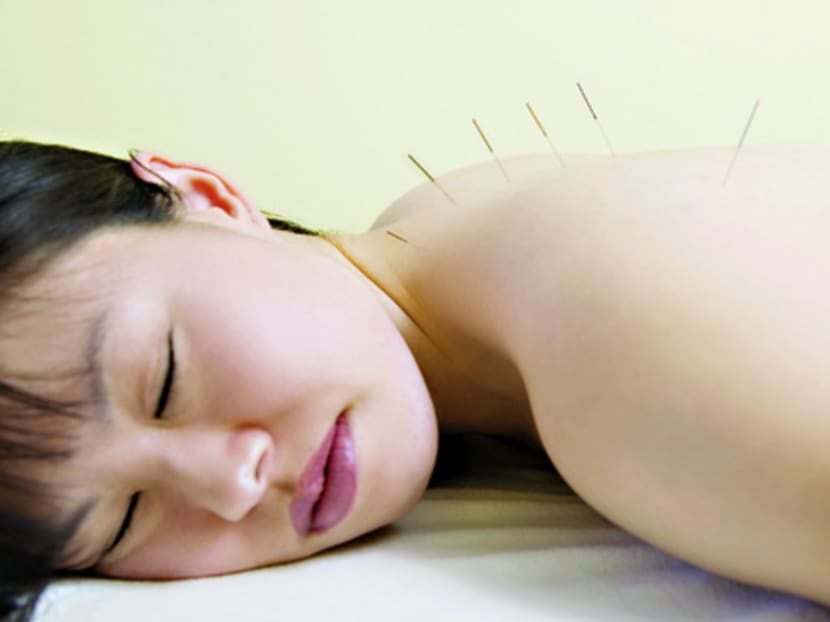Using an East-meets-West approach
SINGAPORE — For years, persistent back and neck pains made Mdm Anisah’s life miserable. The 35-year-old housewife (she has requested to withhold her full name) said the pain worsened during the past six months, rendering her unable to bend, squat or even turn her head.

More doctors are referring patients for TCM treatments. Photo: Thinkstock
SINGAPORE — For years, persistent back and neck pains made Mdm Anisah’s life miserable. The 35-year-old housewife (she has requested to withhold her full name) said the pain worsened during the past six months, rendering her unable to bend, squat or even turn her head.
When conventional treatment did not ease the pain, her doctor suggested giving acupuncture a shot. “I’m glad I did because my back and neck don’t hurt as much now,” said the mother of two children aged five and 10.
Like Mdm Anisah, an increasing number of younger adults are using an East-meets-West approach to relieve chronic back pain.
MORE SEEKING TCM
The number of patients seeking treatment for back pain at the department of Complementary Integrative Medicine Clinic (CIM) department at Tan Tock Seng Hospital (TTSH), which offers alternative therapy such as acupuncture and cupping, has doubled in the past three years.
The CIM department, which gets referrals from TTSH’s orthopaedic department and National Neuroscience Institute, sees an average of 50 new cases of back pain each month. About 15 per cent of them are under the age of 30.
Mdm Anisah attends back-to-back physiotherapy and acupuncture sessions at Raffles Hospital twice weekly. She is also on medication to control her chronic pain.
According to consultant Traditional Chinese Medicine (TCM) physician Miao Meng from Raffles Chinese Medicine, patients such as Mdm Anisah are referred to the clinic by doctors from Raffles Medical or Raffles Hospital to seek complementary treatment.
Most of them complain of stiff necks and shoulders, and lower back pain. The clinic’s TCM physicians also provide inpatient acupuncture treatment upon referral.
BACK PAIN IN THE YOUNG
Nearly nine in 10 people will suffer from back pain at least once in their lifetimes, said Dr Lau Leok Lim, consultant at University Spine Centre at National University Hospital (NUH). The centre saw about 8,000 patients for spine-related back pain last year. A fifth were young adults in their 20s and 30s, shared Dr Lau.
Unlike older adults who get degenerative conditions, younger adults usually get back pain from overuse injury or chronic repetitive injury from long-term poor posture, said Dr Lau. Overuse injuries can occur from repeated strenuous activities such as over-exercising.
Ms Dora Ng, principal acupuncturist at TTSH’s CIM, added that other lifestyle factors, such as lack of exercise, obesity and even smoking, which restricts blood flow around the lower back, can contribute to lower back pain.
HOW TCM WORKS
For most patients, measures such as rest, painkillers or modifying lifestyle activities can help resolve back pain. But about 10 per cent of patients may not improve and may need further intervention, said Dr Lau.
In TCM, back pain is related to imbalances in “qi” (loosely translated as energy) and blood circulation in the meridians of the neck and back, said Ms Miao. Meridians are pathways in which “qi” and blood flow to ensure the body systems function properly, she said.
Practitioners believe that using traditional TCM methods such as acupuncture or acupressure to correct imbalances in the flow helps to improve circulation and relieve pain.
Some sceptics have suggested that improvements felt by patients are purely psychological. However, a 2012 study published in Archives of Internal Medicine suggested that acupuncture might really be effective in providing relief to chronic pain sufferers. The researchers analysed 29 studies involving almost 18,000 participants, and found that it relieved pain by about 50 per cent.
Ms Miao shared that while it is possible to use TCM treatments on their own to treat straightforward cases of back pain, patients can also use them to complement physiotherapy and medication.
However, Ms Ng advised seeing a doctor for an assessment to exclude more serious back conditions before seeking TCM treatment.
“I refer some of my patients who have back pain without any nerve issues for acupuncture. Some of them feel better after a course of acupuncture, but it is imperative to first establish a diagnosis,” said Dr Lau.
Without appropriate management, Dr Lau warned that back pain that results from infection may sometimes lead to paralysis.
CORRECTION: In an earlier version of this article, we named a clinic at Tan Tock Seng Hospital as the Complementary Integrated Medicine (CIM) department. Its correct name is the Complementary Integrative Medicine Clinic. We apologise for the error.





